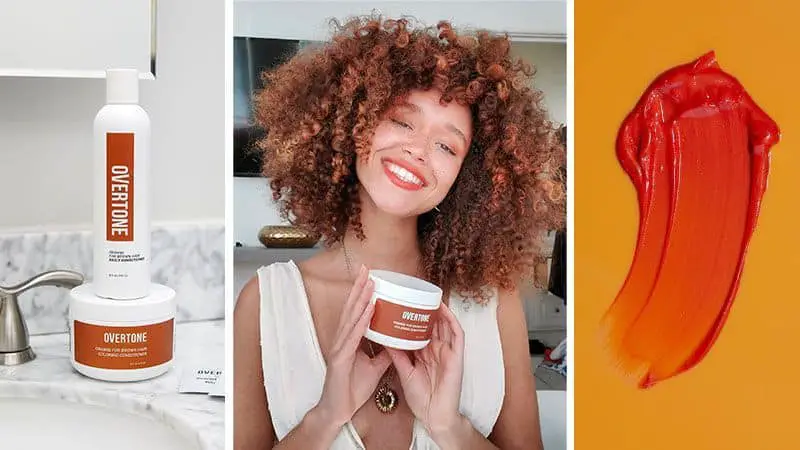OverTone is a popular hair coloring product that allows you to deposit semi-permanent color onto your hair without damaging it. It comes in a variety of fun and vibrant colors that can really transform your look. Many people love using OverTone to subtly enhance their natural hair color or to try out a bright new hair color without fully committing to permanent dye.
However, someOverTone users make the mistake of leaving the product on for too long. This can lead to unexpected results, as the color depositing properties of OverTone become much more intense the longer you leave it on. In this article, we’ll look at exactly what happens if you leave OverTone on for too long and how to avoid potential issues.
How OverTone Works
OverTone contains direct dyes that coat the outside of your hair strands. Direct dyes are large pigment molecules that cannot penetrate into the hair cortex the way permanent hair dye does. This means they sit on top of the cuticle layer and can be washed out gradually over 4-12 washes.
The direct dyes bind to the proteins on the outside of your hair, so the longer they are left to process, the more they are able to adhere and deposit vibrant color. OverTone is formulated to be left on for just 5-15 minutes before rinsing out. This provides subtle, soft color that builds up more with consecutive applications.
However, leaving it on for longer allows the direct dyes to bind to more sites on the hair proteins, resulting in much more vivid and intense color depositing.
What Happens When Left on Too Long
Here’s an overview of what can occur if you leave OverTone on for too long:
– Extremely vibrant, intense color
As OverTone has more time to adhere to your hair proteins, you’ll get a much more dramatic color result. This can be fun if you want a bright new hair color, but it may be more than what you bargained for. The color will appear bolder, richer and more saturated than what would occur with appropriate processing time.
– Uneven color
When you leave any hair color on for longer than directed, you increase the chances of getting an uneven result. The body heat from your scalp causes the product to process more quickly on roots and top sections. This leads to those sections getting more saturated with color than the mid-lengths and ends.
– Potential damage
Most semi-permanent dyes like OverTone are conditioning and damage-free when used properly. But leaving any product on your hair for an extended period can cause drying and hydration issues. On very fragile or porous hair, excessive processing time may also lead to breakage.
– Color that doesn’t wash out
OverTone is designed to gradually fade over 4-12 washes. But when you allow the dyes longer to adhere to the hair, the color will hold on much more stubbornly. This makes it harder to shampoo out and you may have to wait weeks or months for it to fully fade.
| Processing Time | Color Result |
|---|---|
| 5-15 minutes (recommended) | Subtle, soft color that builds up gradually |
| 30-45 minutes | More vibrant, deeper color |
| 60+ minutes | Intense, dramatic color |
What to Do if You’ve Left it on Too Long
Don’t panic if you realize you’ve left OverTone on longer than directed. Here are some tips:
– Rinse with warm water until the water runs clear. This will remove excess direct dye pigments.
– Use a clarifying shampoo once a week. Clarifying shampoos help remove buildup and stubborn color molecules.
– Try anti-dandruff shampoo. The zinc in these shampoos helps fade unwanted color more quickly.
– Use a vitamin C treatment. Crush vitamin C tablets into a shampoo and let sit for 15 minutes before rinsing – this helps remove oxidized color pigments.
– Avoid other coloring products until it fades. Using more overlays of color will make the result even more intense.
– Be patient. It can take 4-6 weeks for overly deposited color to fade back to a more subtle result.
How to Prevent It Happening Again
Follow these tips to make sure you get the right OverTone result next time:
– Carefully follow processing time directions. Don’t exceed 15 minutes even if you want richer color.
– Apply to mid-lengths and ends first, then work up to roots last. This prevents uneven processing.
– Use a timer to track accurately how long product has been on. Set an alarm as a reminder.
– Strand test first for 5 minutes if using a new OverTone shade. Check you like the subtle result before applying all over.
– Rinse hair under cool water first. This closes cuticles and creates an even canvas for color depositing.
– Work in sections and rinse thoroughly between each. Again, this promotes even results.
– Use weekly clarifying treatments after to help remove excess color pigments if needed.
Conclusion
OverTone gives the most predictable results when used exactly according to directions. Leaving it on too long leads to extremely vibrant color that may be challenging to remove. Follow the timing guidelines, apply carefully to all sections and rinse thoroughly. This will give you beautiful, soft color that builds up gradually with each use. Be cautious with processing times and prevent overly saturated color by strand testing first. With some patience, any unwanted intense results from improper application can fade back to a more subtle color over a few weeks.


